Jubilation. Disappointment. Pride. Ecstasy. Resentment.
National competitions provide a fertile ground for many emotions, but there’s one that drives them all. Hope.
Hope has you broadcasting ‘It’s coming Home’ out on the office speakers three days before your country have even kicked a ball.
Hope has you frantically scribbling down predictions on your wall chart, conspicuously designing a route to glory that could maybe yeah I can see that happening I guess?
Hope has you proudly donning your national shirt and praying to yourself that this year, this summer and this team is the one to have you screaming the immortal words of Freddie Mercury… ‘We are the champions’.
For the European Championships in 2020, many nations will be entering the tournament with hope in hand. And to misquote Uncle Ben – “With great hope, comes great speculation”. With the bounty of great footballing nations present, predicting finalists yet alone winners is incredibly difficult.
Italy and Belgium have both had perfect qualifying campaigns, racking up 30 points from a possible 30. Italy are under the stewardship of Roberto Mancini and led by one of the most inform strikers in Europe in Ciro Immobile -you’d have to fancy them to have a chance.
Moving on to Belgium, do I need to say more than; Kevin De Bruyne, Eden Hazard, Romelu Lukaku, Thibaut Courtois, Youri Tielemans and Thomas Meunier?
France are the current World Cup holders and both them Spain, Germany and Portugal will enter the tournament with the added expectation that recent success inevitably brings.
Both England and Croatia were unexpected performers in Russia and will enter the tournament confident on the back of strong qualifying campaigns. England profited from the withdrawal of expectation in Russia 2018. Gareth Southgate won’t have that benefit this time, with England fans becoming more hopeful that the current squad have enough quality to mount a real case for European success.
One team that have had a quietly encouraging qualification campaign are Holland. Managed by Ronald Koeman, The Flying Dutchmen have won six of their qualifiers, drawing and losing only once. To add to this, they also have an impressive amount of talent at their disposal. UEFA Men’s Player of the Year Virgil Van Dijk partners Gini Wijnaldum as Dutch Champions League winners.
Memphis Depay has scored 62 goals for club and country since leaving Manchester United, and Frankie De Jong is one of the most exciting talents in La Liga right now.
In defensive areas, Holland are spoilt for options. They have a criminally underrated an extremely versatile Daley Blind. Denzel Dumfries is an exciting talent too at right back.
Regarding centre backs, Holland have enough to field two championship winning teams.
The aforementioned Virgil Van Dijk is an incredible asset. Bournemouth’s Nathan Ake and Inter’s Stefan De Vrij are both enjoying selection worthy seasons too. However, Ronald Koeman has his preferred partner to VVD. It’s the player who is the focus of this analysis and the man that cost Juventus €74m, Matthijs De Ligt.
Ronald Koemans current tactics
Seldom straying away from it at Everton and Southampton, Koeman looks settled on a defensive four with Holland. For all but one qualifier, he’s played either a 4-2-3-1 or a 4-3-3. The one game he set up in a 3-5-2, his side shipped three to Germany.
Having only conceded the same amount as Germany (7), Ronald Koeman may not be under too much stress to tweak. However, conceding five goals to Germany is a cause for concern. Holland will concede goals against tougher opposition, and given that Germany scored less than England; Spain, Italy, Belgium and Russia in the qualifying rounds, this should be an area of focus for Koeman before the Championships.
By only playing with two central defenders, positional awareness is of paramount importance. Worryingly for Ronald Koeman, his team have conceded many goals through lack of positional awareness.
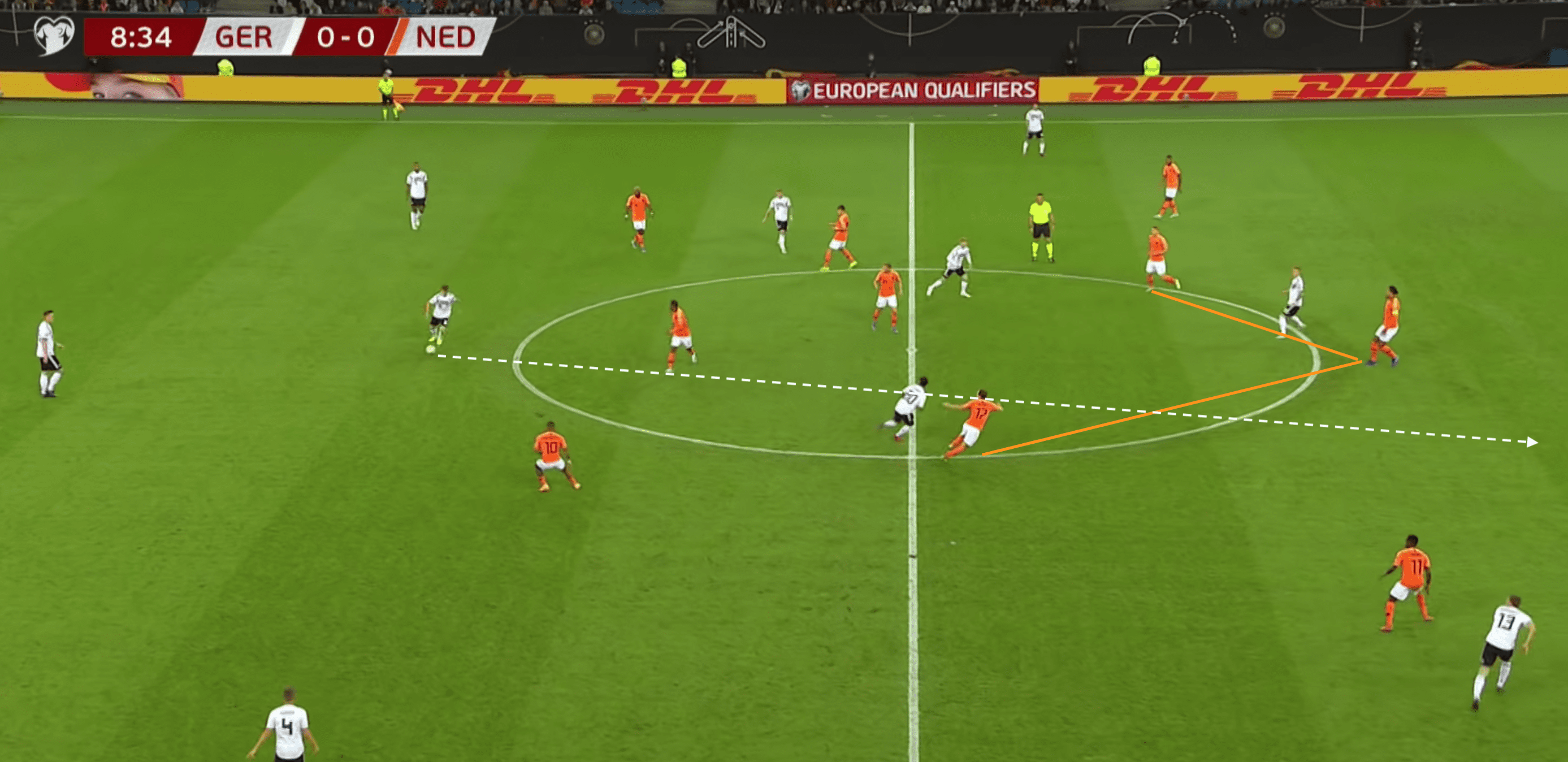
The above frame shows the erratic backline that led to Germany’s first goal. Both De Ligt and Blind have been dragged towards the play leaving too much space for Kimmich to find the right pass.
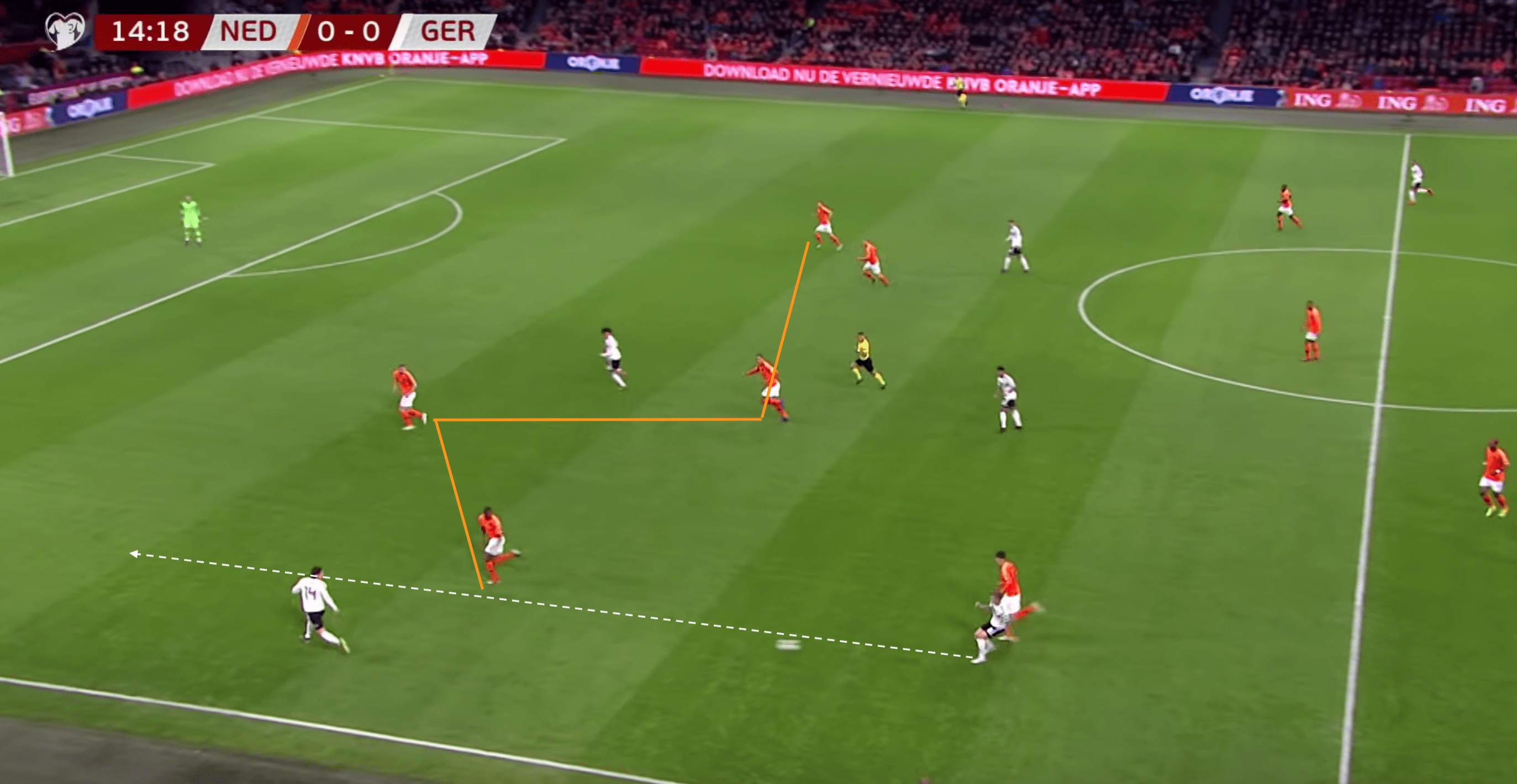
De Ligt and Van Dijk also struggled with their positioning in the return fixture. Germany’s pace when transitioning from defence to attack caught the defenders out. Attacking a defence that is set up in more of a zig-zag than a line opens up more routes to goal and inevitably, more chances for the attacking team.
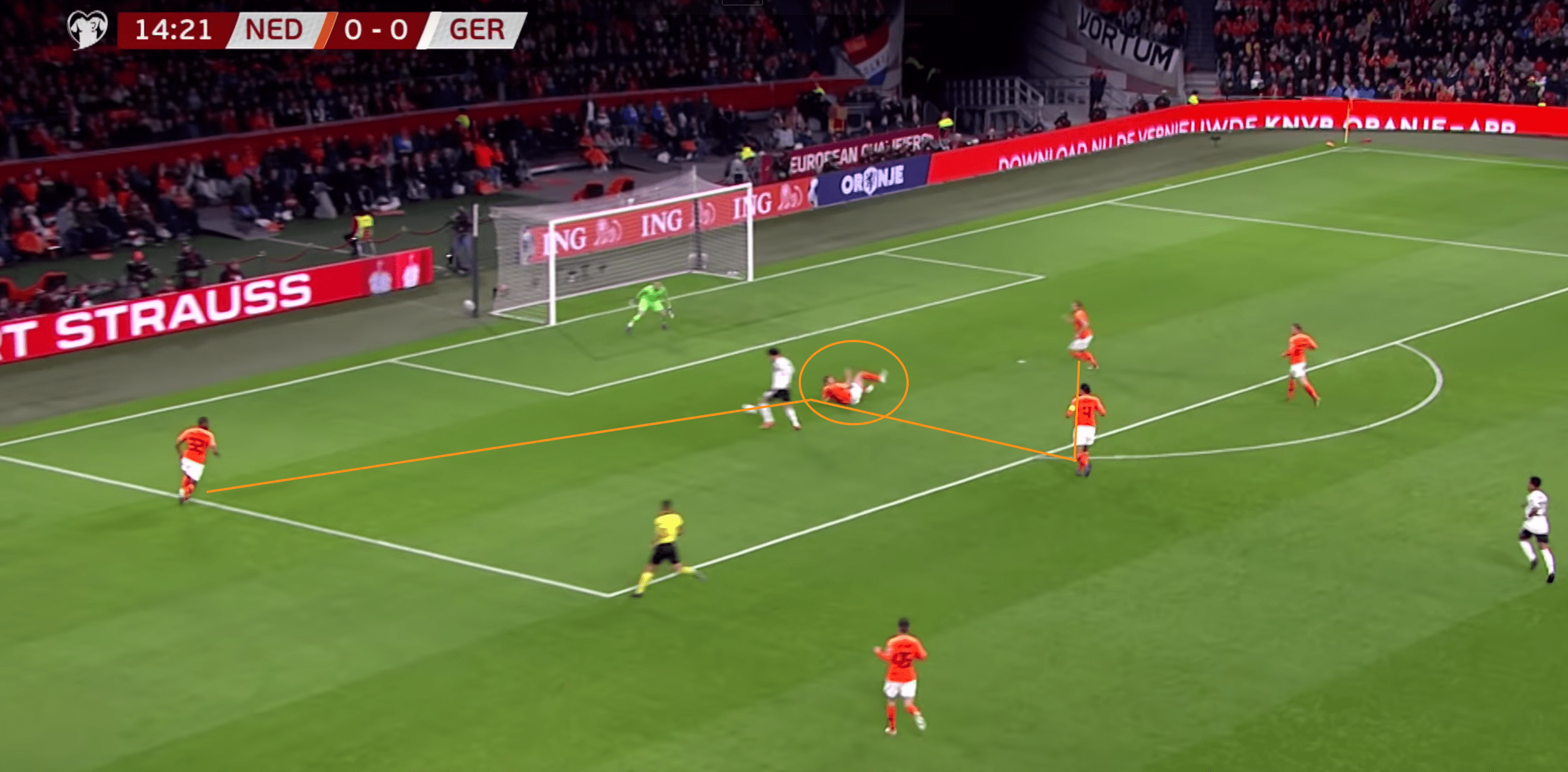
Matthijs De Ligt, having twisted and turned multiple times to find the right position, ends up on the floor and affords Leroy Sane an easy chance to score.
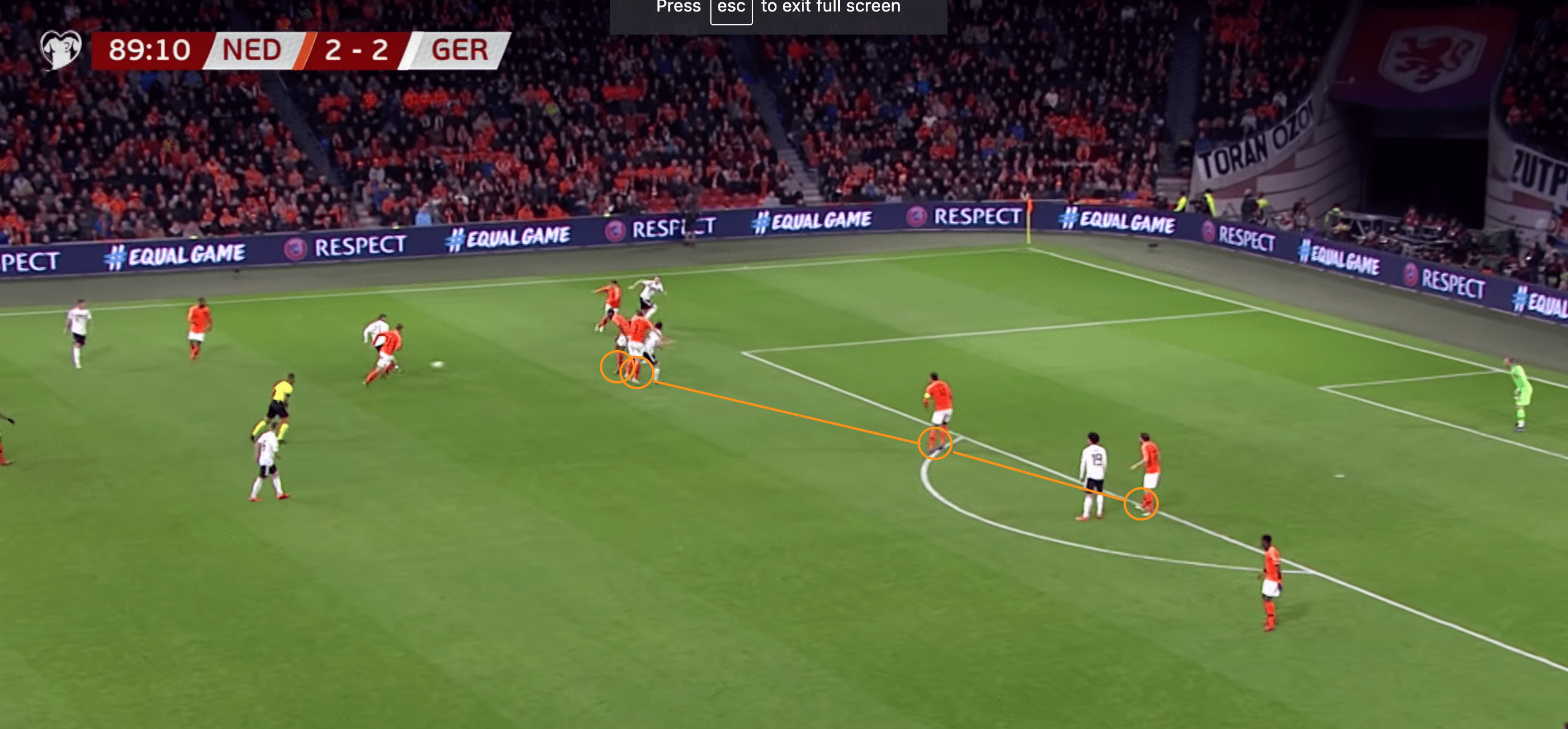
Again we see a confused defensive line for Holland. Denzel Dumfries and Matthijs De Ligt collide whilst marking the same man, whilst Germany utilise that extra space to score the winner.
An inexperienced desire to win the ball in the last minute relinquished a point in an important game for Holland. Ronald Koeman will be aware of the dangers of doing that in the competition and may need to assess at the central defensive pairing.
Is Stefan De Vrij a better defensive partner to Van Dijk?
If positioning between the two central defenders is a contributing factor to the Dutch conceding goals, would it be worth considering the astute and athletic Inter defender – Stefan De Vrij?
The 27-year-old has been a defensive giant for Internazionale since signing from Lazio in 2018. He is calm and competent in possession and reads the game superbly well without.
Although Milan Skriniar is the poster boy for Inter’s defence, Stefan De Vrij is as vital a cog for its stinginess. It’s clear that he’s a massive part of Antonio Conte’s tactics too – starting 11 out of the 13 Serie A games in Conte’s 3-5-2 formation.
Our earlier analysis has identified that De Ligt can sometimes be caught out positionally. To understand if this is something that De Vrij can help solve, it’s important to see how they both compare. Identifying who is better positionally, first requires a grasp of the metrics that can help to narrate this:
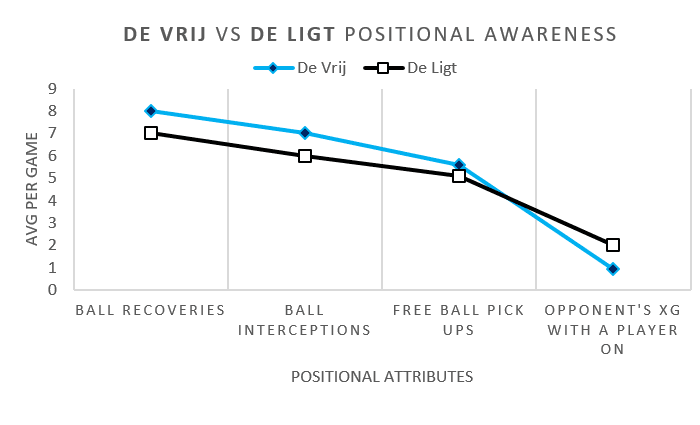
Ball Recoveries & Ball Interceptions:
Ball recoveries are the picking up of loose balls from poor control. Interceptions are recorded when the player has intercepted an opponent pass. De Vrij has a higher average per game for both metrics showing that he is usually closer to play. Higher interceptions suggest his positional awareness has been better than that of De Ligt this season, reading the opposition well and cutting out passing lanes.
Free ball pick-ups:
These relate to good defensive positioning as they are the times that the defender picks up the ball from a wide pass, or another defensive challenge. A higher average suggests that De Vrij is more astute to more where opponents may make a mistake and quicker to capitalise than his comparison.
Opponents xG with a player on:
This metric refers to the xG (Likelihood of a goal scored) by the defenders’ opponent when they take a shot. This directly relates to the defenders positioning as good marking will reduce the strikers’ chances of scoring. On average, De Vrij’s opponents are afforded less lucrative chances compared to De Ligt.
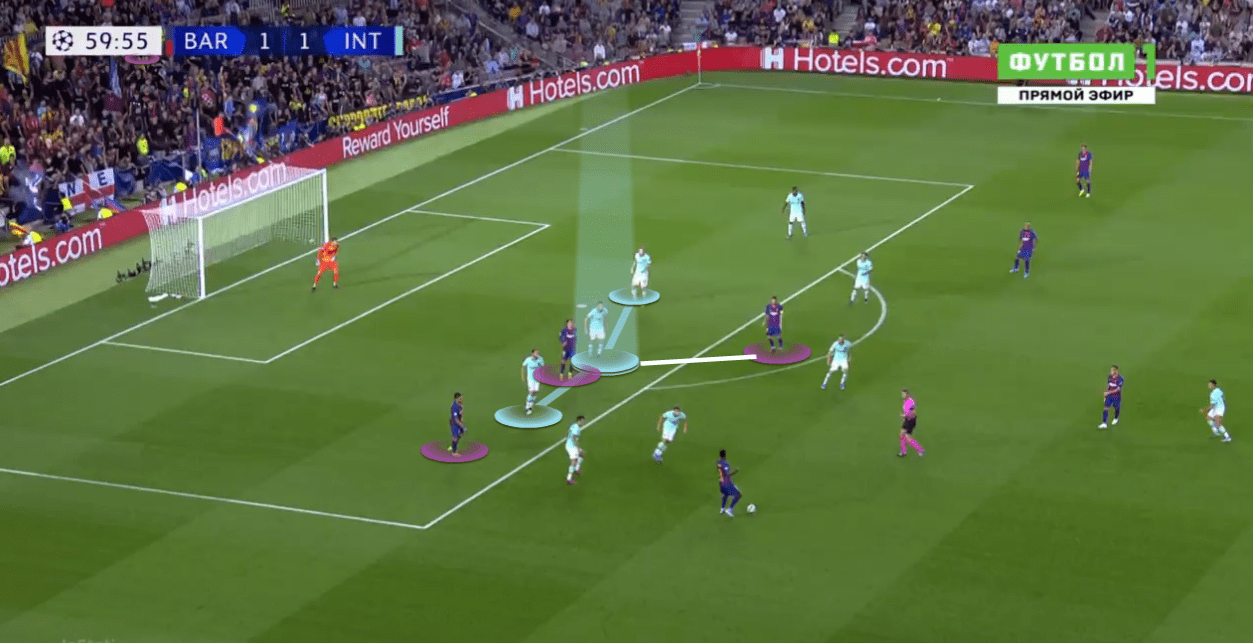
This example in a Champions League tie at Barcelona show the positional understanding of De Vrij. He’s sat in the middle of a defensive three and although his job is to mark Antoine Griezemann, he spots the danger of an unmarked Lionel Messi on the edge of the box.

Having realised that the channel to Griezemann is blocked by three Inter defenders, De Vrij is able to step out of his position and close Messi down. He holds his run until split seconds before the ball is played, and moves out with speed to intercept.
This quick thinking and awareness sets him out above De Ligt in terms of defensive solidity. His ability to read danger well would provide Holland a more composed partner for Virgil Van Dijk – and potentially a defence more likely to cut out opposition chances before they become dangerous.
The only doubt Koeman will have to consider is whether the system he operates is suitable for De Vrij. De Vrij commonly operates in the middle of a defensive three, whereas De Ligt has been playing within a defensive four under Maurizio Sarri at Juventus. As Ronald Koeman has tactically favoured a back four, it may be seen as a gamble bringing in a centre back that is playing in a different system.
When analysing success rates of defensive actions, both defenders have their different strengths and weakness’:
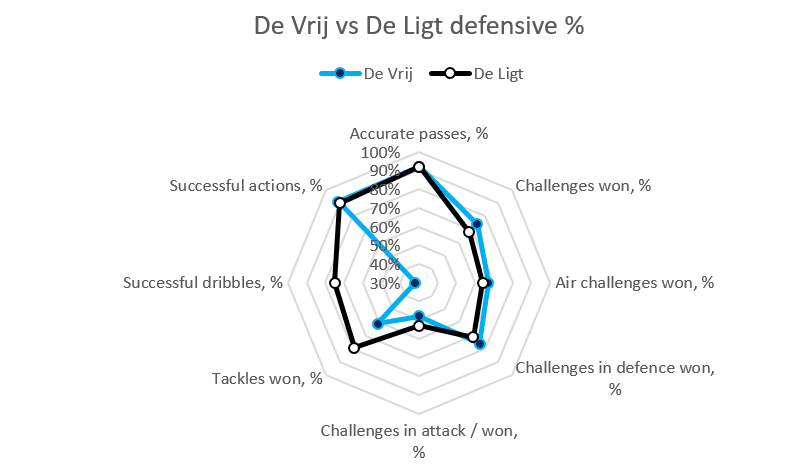
It’s clear to see where Matthijs De Ligt outperforms his national teammate here. For attributes such as; Successful Dribbles, Tackles Won and Challenges in Attack, De Ligt has a higher percentage per game. This is unsurprising for a defender that has graduated under Erik Ten Hag at Ajax. He’s also more youthful, energetic and throws himself into tackles more often than the controlled De Vrij.
However, what you gain with De Vrij is, in some ways, more crucial to good defending. He wins more challenges, and in particular the duels that matter – in defence.
De Ligt has a reputation for scoring from corners, with notable goals against Tottenham and his current team Juventus. For a 22-year-old with 19 goals to his name – that is well justified. However, De Vrij actually posts a better percentage of Aerial Challenges won, again showing that defensively he is more accomplished.
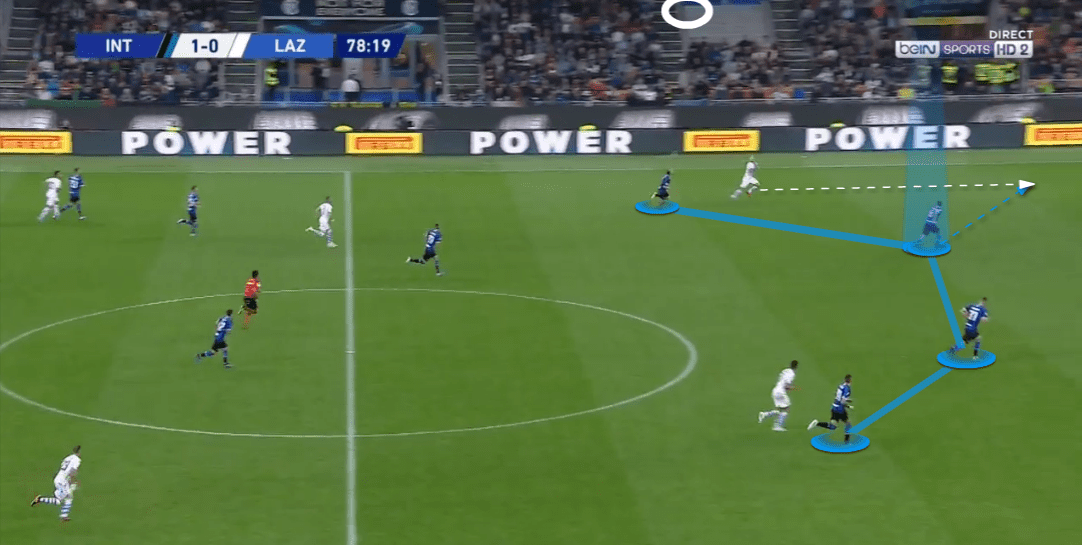
In the frame above, De Vrij is defending a long ball late on as Inter are holding on to a one-goal lead against Lazio. He has spotted the danger of the Lazio forward beating the Inter defender and reaching the pass first. Deciding not to fall back into shape and wait for Godin to double up, he reads the flight and goes to intercept.
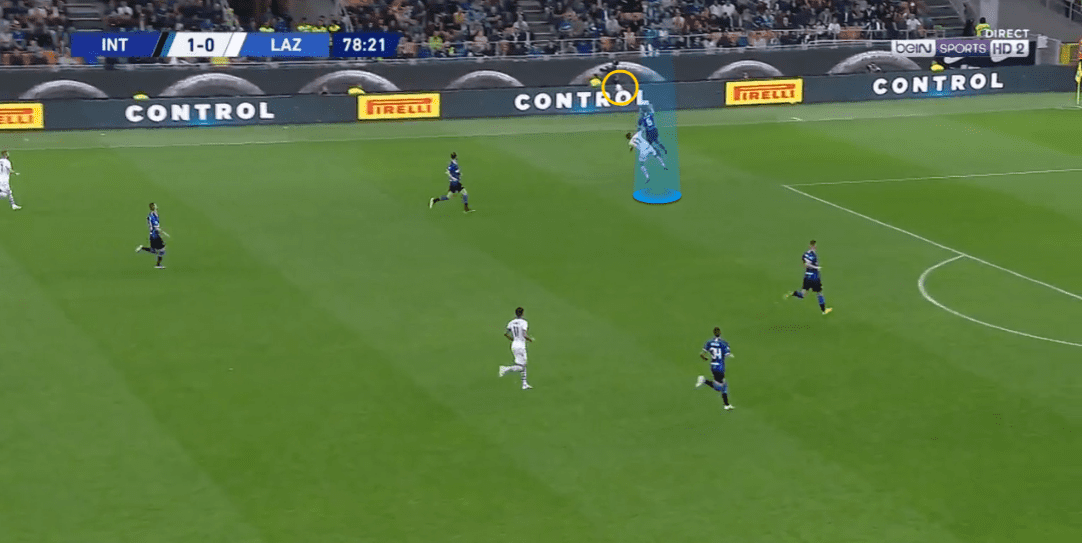
De Vrij has read the flight perfectly and rises to meet it before the Lazio forward. Importantly, he also leans into Immobile when jumping – knocking him off balance and allowing himself more time to clear the loose ball.
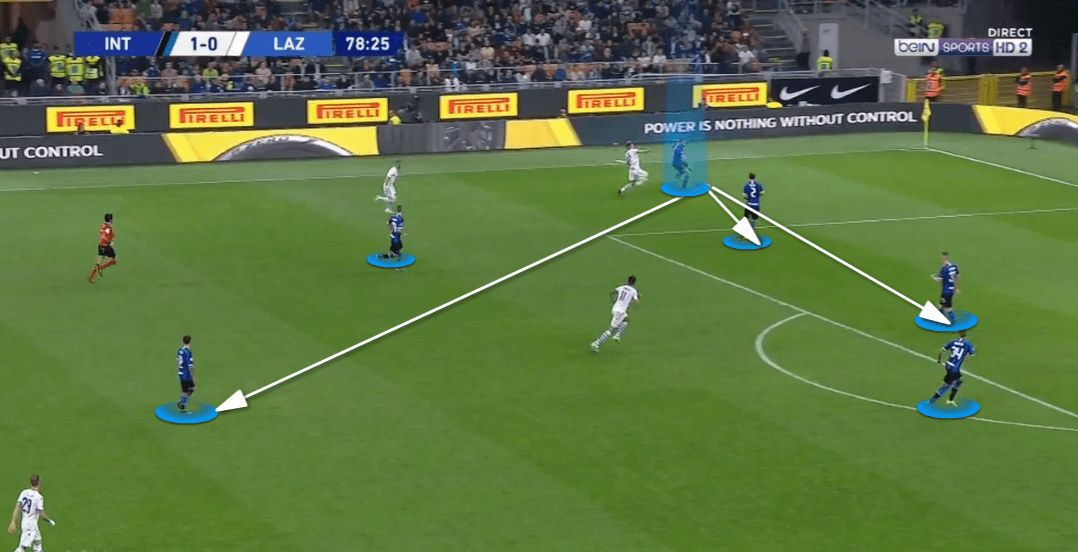
As the Inter defender manufactured some time for himself in the interception, he has been able to turn back on himself to find ways to retain the ball. Godin and Skriniar are now back and in a position for an easy pass out of danger. The ball to Sensi is risky but available too. This example of great awareness and composure to win the ball and retain possession is something that would greatly benefit Holland in the European Championships.
De Ligt on the other hand, is not as accomplished when defending in the air. The below visual shows all the positions that he has lost an aerial challenge over the last year. His own box is on the right, and the opposition’s on the left. As a defender, you’d expect more aerial challenges to be lost in the opposition box rather than his own, however six failed aerial chances in his own box is a worrying volume (given that it’s double De Vrij’s amount over the same period). This could be a cause for corner for Ronald Koeman.
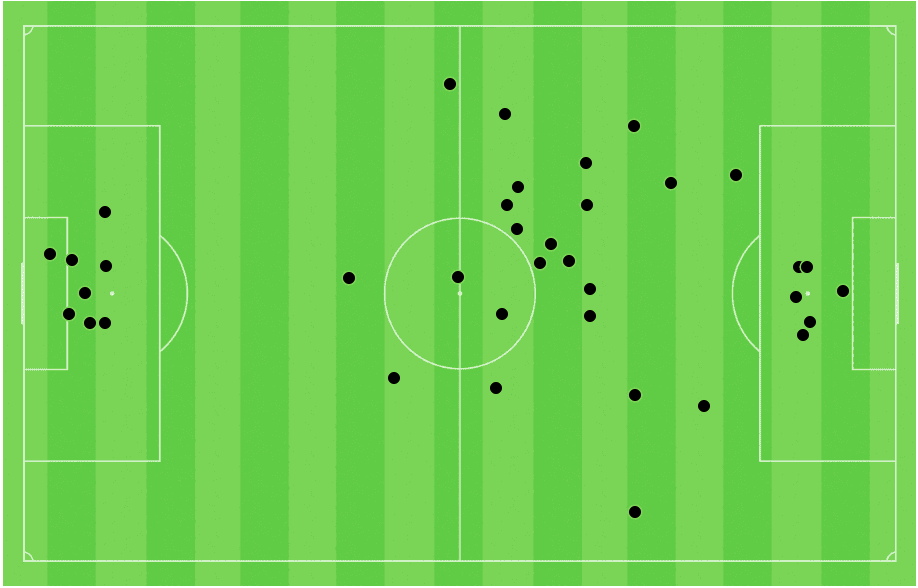
De Ligt discipline
Set Pieces. In the modern game, they are being used and discussed on par with VAR at the moment. We are currently in an explosion of set-piece exploitation, with international tournaments at the forefront of this. As national teams have less time to work together on precise philosophies and nuanced tactics, many managers see set pieces as a way to build marginal advantages.
This was particularly evident in the Russia World Cup in 2018. According to Fifa, 42% of all goals came from set-pieces and 15/32 teams had set pieces to thanks for over 50% of their goals.
With national opponents likely to be preparing set-piece strategies, it would be prudent to try and build a defence on good discipline.
In 2019, De Ligt committed just under double the amount of fouls than De Vrij (42 vs 22). This equates to 2.5 every game which potentially could become a point of weakness for Holland. Although you could argue that in Van Dijk, you have a player capable of defending set-pieces, though it’s not something you want to rely on. If Italian fans are joking about De Ligt being a ‘volleyball player’ on account of multiple handballs, it’s clear that there may be an issue.
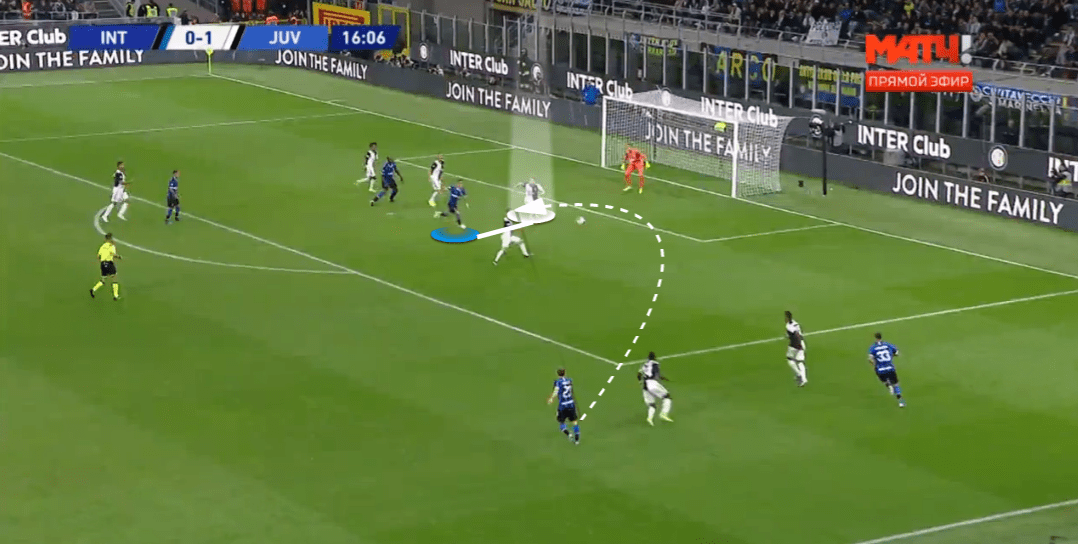
The frame above shows a clip from the Inter–Juventus match whereby Inter win a penalty. Barella has just crossed the ball and you can see initially, De Ligt is not tight enough to the Inter striker – Latauro Martinez. In his attempts to win the ball still, he runs through Martinez and inadvertently handles the ball.
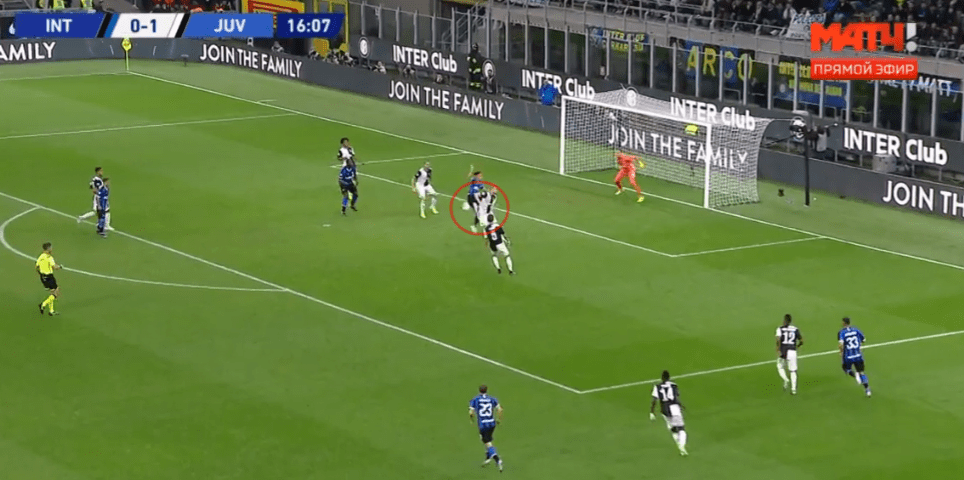
Although many of his best qualities are based on his energy and desire to meet the ball, this can be twisted to the advantage of opposition teams that exploit his poor decision making. Ronald Koeman will have to make the decision as to whether the increased likelihood of him conceding fouls is a price worth paying for a bigger threat in the oppositions box.
Conclusion
It’s clear that Holland have a chance of progressing to the later rounds of the Euro’s. They have a squad concentrated of talent and will feel they have as much chance as anyone else this summer. What this analysis does, is pose the question – has Ronald Koeman side-lined his best centre half for a highly rated prodigy?
Matthijs De Ligt is good, great even. There’s a reason why Juventus made him the world’s fourth most expensive defender. However, could youthful exuberance make him a greater liability than an asset in a national competition? He can be impetuous, and his discipline record is a perfect reflection of that. With many nations utilising set pieces with great effect, it may be that Koeman could use a centre back that is less erratic.
When comparing the two defenders side by side, De Vrij often edges it. His positional awareness and composure when in difficult situations may be missed if Holland select Matthijs De Ligt to partner Van Dijk.
However, Ronald Koeman favours two central defenders within a back four. This is an advantage for De Ligt as he plays in this system weekly under Sarri at Juventus. De Vrij has often operated within a back three, meaning his tactical awareness may be hampered in a different system.
Either way, Holland have an arsenal of good defenders to call on for the European Championships. Honourable mentions are deserved for Nathan Ake, Daley Blind and Denzel Dumfries. Further, they’re not the only team with defensive issues going into the tournament. For example – England have selected a different defence for near enough every game in qualification. Italy too have an ageing defence with few fresh options.
It will be interesting to see how Holland perform in the tournament, and if you see Stefan De Vrij sat forlorn on the bench – spare a thought for the Inter defender that has been statistically divine all season.

If you love tactical analysis, then you’ll love the digital magazines from totalfootballanalysis.com – a guaranteed 100+ pages of pure tactical analysis covering topics from the Premier League, Serie A, La Liga, Bundesliga and many, many more. Buy your copy of the November issue for just ₤4.99 here






Comments